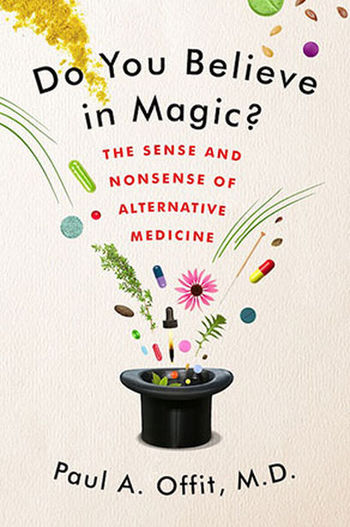 Written by Lauryn Smith Do you believe in magic? Not the magic in a young girl’s heart, but the magic that is alternative medicine. (Sorry, had to.) I never used to oppose the magic of natural remedies, but then I read Paul A. Offit’s accessible and engaging nonfiction book “Do You Believe in Magic?”. Now I am much more leery. Alternative medicine, which includes things like megavitamins, acupuncture and homeopathy, is not all it is cracked up to be, so says Offit in his well-researched, objectively written book on the matter. In fact, Offit presents insurmountable science-based evidence that many forms of alternative medicine do more harm than good. The events Offit chooses to portray in the book illustrate why alternative medicine has become widely accepted as a desirable alternative to mainstream medicine. To many, it is definite, spiritual, meaningful and empowering, and it stems from ancient wisdom... right? Offit explains that there is no evidence that alternative medicine does what it claims to do, that is, heal. I repeat, no evidence. Zip. Nada. Goose egg. (No, personal testimonials do not count as evidence.) In fact, Offit shows that the few studies out there—blame the scarcity on politics—often support the exact opposite. The evidence is not limited to a single arena. Chiropractic manipulations can result in torn arteries. Supplements can cause psychosis, heart arrhythmias, brain swelling and other problems. Megavitamins can increase the risk of cancer. Perhaps of the most interesting alternative remedy Offit discusses is acupuncture, the Chinese practice of balancing energies by placing thin needles under the skin, which is often viewed as 100 percent healthful. The practice has been around for ages, after all. Ancient Chinese healers, though, were not allowed to dissect human bodies and thus did not understand anatomy like we do today. Instead, they based needle placement on the rivers that run through China. Those same needle placements are used today, and not innocently. There are records of viral infections caused by contaminated acupuncture needles, as well as needles ending up in lungs, livers or hearts. Use that impressive little factoid at your next dinner party!
Proving himself objective, Offit does not discount the positive aspects of alternative medicine that have been verified, even though those outcomes oftentimes arise from the placebo effect. The placebo effect is powerful, which, ironically, Offit uses acupuncture to illustrate. He defends it well, saying that just because a treatment will not work better than a placebo does not mean it will not work as a placebo. While some alternative therapies are still around and can be beneficial in ways other than those claimed directly, there have been myriad remedies that, upon reflection, appear mystifyingly stupid. Offit gives examples from many periods throughout history, some surprisingly recent, such as the late-1970s idea that taking laetrile, which is made from crushed apricot pits, can cure cancer. (It does not cure cancer.) Offit makes readers aware of how easily alternative healers can cross the line of "quackery." He argues that healers should not advise against conventional therapies that are proven to be helpful. They should not promote potentially harmful therapies. They should not drain people’s bank accounts for no good reason. Even though he concedes to the power of deception in medicine, Offit could have spoken more on which alternative therapies, if any, are useful. Maybe that is just hopeful thinking on my part. Maybe the book did its job, implying the lack of effective alternative medicine techniques. I understand that contemporary therapies are for the best, but you have to admit—they just do not have the charm of natural remedies. Besides presenting study results and a basic history of medicine, Offit allows readers to consider for themselves the logic, or lack thereof, of most alternative remedies. How is it possible that coffee enemas, for example, can cure ills ranging from cancer to autism to aging? The sensibility, we see, just is not there. Sometimes the public is simply unaware. For instance, many people do not realize that all cancers cannot be treated the same way. I studied biology as an undergrad, so I understand that the mechanisms responsible for one type of cancer can be, and probably are, vastly different from those of other types. One solution does not fit all. Offit effectively brings this idea to readers' attention, and he questions why some health “professionals” insist on claiming a single cure-all. (You gotta read “Do You Believe in Magic?” to see why I am putting “professionals” in quotes). Offit focuses largely on irresponsible practitioners of alternative medicine. Perhaps he could have included mention of those who practice it innocently, more than his brief note at the end regarding the synergistic relationship between mainstream and alternative medicines, granted his statement powerfully illustrates that both have their place in society. “Do You Believe in Magic?” presents unsettling concepts. It is disturbing that some healers can be so oblivious to the fact that they are hurting people or so insensitive and out for personal gain that they actively take advantage of people despite inherent dangers. Offit's book is full of stories of real people affected by the ill-effects of alternative medicine, as well as stats illustrating the widespread extent of the matter. So while the content is very enlightening, it is also quite worrisome. Anyone interested in their health and the health of others should read “Do You Believe in Magic?”. I did not touch on the politics involved, but that is another prominent aspect of the book. Honest, objective books like Offit’s provide insights worth sharing. There are many preventable illnesses and unnecessary deaths occurring. “Do You Believe in Magic?” is eye-opening in that it argues the importance of making informed decisions, which is key in preventing these things to continue to happen. Title: Do You Believe in Magic?: The Sense and Nonsense of Alternative Medicine Author: Paul A. Offit, M.D. Publisher: Harper Publication date: January 1, 2013 Page count: 336 List price: $26.99 ISBN: 978-0062222961
0 Comments
Your comment will be posted after it is approved.
Leave a Reply. |

Enjoying my book reviews? If you’ve found them helpful or simply love diving into a good book, consider supporting my caffeine-fueled reading sessions! Your contribution helps keep the reviews coming and ensures I stay wide awake for those late-night reading marathons. Cheers to a shared love for literature! ☕️
Categories
All
|
